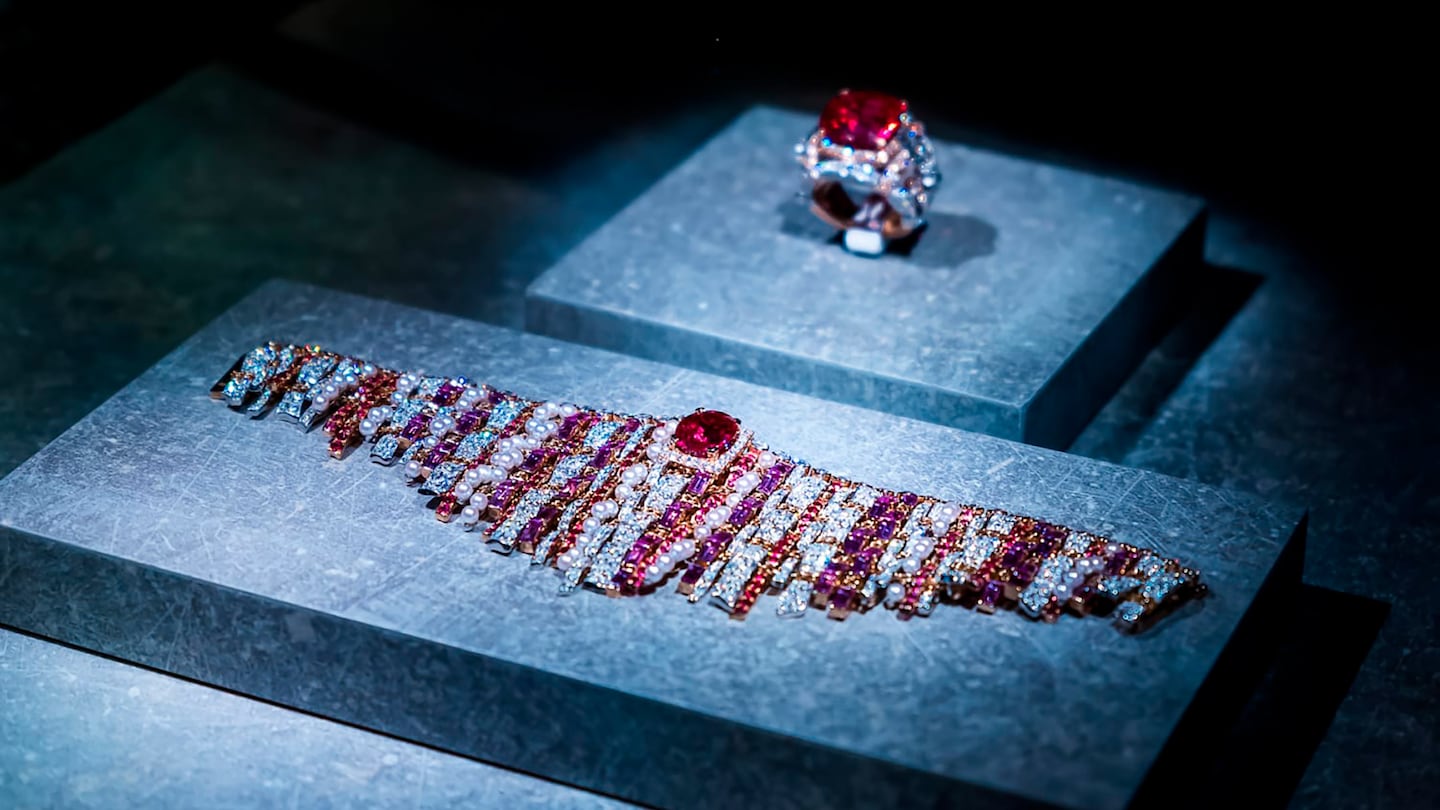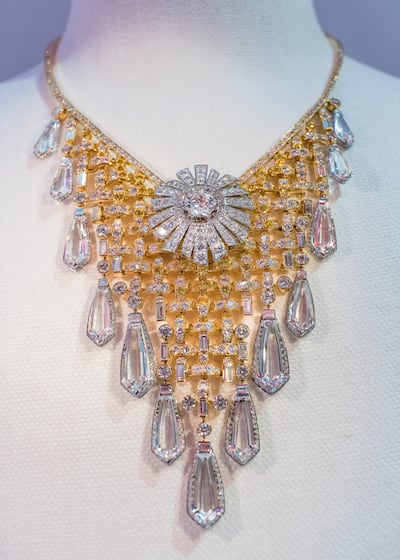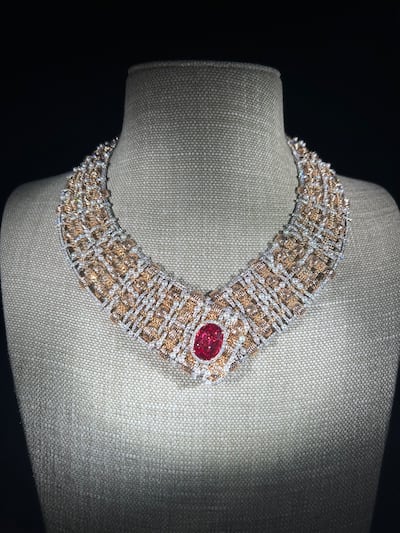
The Business of Fashion
Agenda-setting intelligence, analysis and advice for the global fashion community.

Agenda-setting intelligence, analysis and advice for the global fashion community.

For decades, Chanel has celebrated its signature tweed across jackets, skirts, bags and more. But this week, the house’s most loyal — and wealthy — clients will have a chance to get their fix of Chanel tweed in diamonds and sapphires instead.
This week, the house has flown guests from around the world to London to view its latest high jewellery collection. The line, designed to mimic the suppleness and intricacies of tweed fabric using precious stones, is the second to be inspired by the iconic material, but the first to be displayed to clients at a large-scale event (presentations for a tweed-inspired high jewellery collection in 2020 were cancelled due to the pandemic).
The collection, all crafted in Chanel’s workshop in the Place Vendôme, is larger than its predecessor: with 63 one-off designs, compared to 43 pieces in 2020, it marks a major push for Chanel in the high jewellery segment, which is shaping up into a key battleground for luxury brands seeking to ramp up their exposure to hard luxury and top-spending “VICs” (very important clients).
Woven necklaces and bracelets imitate the texture of Chanel’s multi-coloured tweeds using diamonds, pearls and spinels, with miniature camellias hidden among the stones. Pieces inspired by the buttons on Chanel’s signature tweed jackets sit beside playful asymmetric earring sets and gob-stopper sapphire and diamond rings.
ADVERTISEMENT

“This is extraordinarily important for us, because this is a new language for high jewellery,” said Frédéric Grangié, president of watches and fine jewellery at Chanel, emphasising the technical complexity of recreating the qualities of fabric using precious stones. “Patrice [Leguéreau, director of Chanel’s fine jewellery creation studio] had that in mind for 14 years, but it really takes a great level of craftsmanship to be able to do it.”
Chanel has been surging since the pandemic, with revenues hitting $17.2 billion last year, up 17 percent over 2021. To fuel its next chapter of growth, the house now plans to push even further upmarket — providing clients with the “ultimate luxury experience,” chief executive officer Leena Nair told BoF last month. The house has rolled out dramatic price increases, opened private salons dedicated to serving its top clients, and reportedly placed purchasing limits on certain items. Capital investments, including in swanky store renovations and acquiring key suppliers, are set to double to around $1.2 billion, Chanel said.
Burnishing its authority in high jewellery will be a key part of the puzzle. While Chanel has long played in this space (founder Gabrielle Chanel debuted its first high jewellery collection in 1932, and the company has regularly produced bi-annual collections since the 1990s), in recent years the house has been “investing heavily” in the ultra-luxe category, said Grangié, although he declined to divulge any figures.
“The role of high jewellery beyond clients is really to continuously lift the brand and elevate it,” said Grangié. “We feel very strongly about high jewellery. It is a booming business.”
Chanel isn’t the only brand doubling down on the category: names from Tiffany to Dior are also ramping up investments in high jewellery as a means of anchoring their top-end positioning. Both brands staged large-scale launch events for their collections this week. As the broader luxury market faces slowing sales in the key US market following a post-pandemic boom, particularly among aspirational and middle-class shoppers pinched by inflation, brands see maintaining close ties with the wealthiest clients as even more crucial.

“The very high end consumers are driving a disproportionate amount of market growth. High jewellery is effectively positioned to appeal to them,” said analyst Luca Solca, head of luxury goods at Bernstein.
Despite tiny volumes for each collection, ultra-elevated price points allow high jewellery to drive as much as 20 percent of revenues for some luxury jewellery brands, Solca said. This season, prices for pieces from Chanel’s Tweed collection start at €65,000, and go up to €5.8 million for the “masterpiece” — an intricate “Tweed Royal” necklace, which took 2,400 hours to make.
It doesn’t hurt that high jewellery has evolved in recent years into a highly profitable proposition, a contrast to its sister category in fashion, haute couture, which is often seen as a loss-making image-play. Top brands have found a burgeoning audience for one-off creations using priceless stones, with the scarcity of pieces driving up prices and helping to recoup their investments.
ADVERTISEMENT
Jewellery represents a significant growth opportunity for luxury companies. The vast majority of the market remains unbranded, leaving plenty of blank space for big name brands to expand. Going into the pandemic, it was the fastest growing segment of the personal luxury goods sector, expanding at a compound annual growth rate of 10 percent between 2014 and 2019, according to Bernstein. Superior growth rates and long product cycles make it a “very attractive niche,” said Morningstar analyst Jelena Sokolova.

As such, Chanel’s broader trade in fine jewellery and watches has become a priority for the brand in addition to its high-jewellery range: collections like the Comète line (recognisable for its star motifs) and Coco Crush (with cross-hatched engravings that match its quilted bags) are pillars of the brand’s jewellery division.
Watch models like the ceramic J12 diving shape, Boyfriend and Code Coco have also grown into a significant business. Last year, the brand relaunched its first-ever Swiss-made watch, the Première Edition Originale, which debuted in 1987.
Chanel’s success selling women’s watches, which make of 95 percent of the range, is an unusual bright spot in a category dominated by men. The brand has burnished its credibility and pushed its price point upwards by developing Swiss-made mechanical movements to sell alongside more accessible quartz models. Chanel has continued to invest in strengthening its watchmaking operation, most recently purchasing stakes in independent luxury watch brand F. P. Journe and Kenissi, the manufacturer behind some Rolex-owned Tudor watches, in 2018.
Last year, the brand reopened its historic watch-and-jewellery flagship on Paris’ Place Vendôme after a sweeping renovation.
“The investments that we have done from day one — meaning that from day one we wanted to be vertically integrated and have the positioning of a pure player — is really starting to make a difference,” said Grangié.
Chanel now has 58 dedicated locations for watches and jewellery, with plans to open two more over the next year. Watches and fine jewellery are also sold in over 200 Chanel fashion boutiques, as well as through about 350 high-end watch dealers, including Wempe and Bucherer.
In addition to its luxe image and growth potential, watches and jewellery help Chanel with cross-selling and building lasting relationships with shoppers, Grangié siad.
ADVERTISEMENT
“What’s interesting with jewellery, and watches to some degree, is the fact that you create the loyalty to the brand,” he said. “It is something that people feel connected to in a very strong, emotional way. It plays an important role in the way we look at the client journey.”
Even as high jewellery evolves into a promising business for Chanel, Grangié says that image and innovations will continue to take precedent over the bottom line for the category.
“We will never lose the focus on why we are doing it in the first place, which is really that tip of the pyramid that will continuously elevate the brand. That is our absolute priority, and to bring the creations to life,” he said. “From there it becomes a business. Not the other way around.”
Editor's Note: This story was updated on June 9, 2023, to clarify that Chanel relaunched its Première Edition Originale watch last year.
The privately-held fashion and beauty giant’s sales rose 17 percent to $17 billion in 2022. Private salons for top-spending clients, emerging technologies and a new London headquarters are on new CEO Leena Nair’s agenda.
The French luxury giant said 2021 revenues rose 23 percent over pre-pandemic levels to $15 billion. The brand now plans to open dedicated boutiques for top-spending clients as rapid growth risks overcrowding its stores, CFO Philippe Blondiaux revealed.
The Business of Fashion and McKinsey & Company are pleased to present our State of Fashion Watches and Jewellery Report. Download the full report here.
The sharp fall in the yen, combined with a number of premium brands not adjusting their prices to reflect the change, has created a rare opportunity to grab luxe goods at a discount.
Fashion’s presence at Milan Design Week grew even bigger this year. Savvy activations by brands including Hermès, Gucci, Bottega Veneta, Loewe and Prada showed how Salone has become a ‘critical petri dish for dalliances between design and fashion,’ Dan Thawley reports.
The Hood By Air co-founder’s ready-to-wear capsule for the Paris-based perfume and fashion house will be timed to coincide with the Met Gala in New York.
Revenues fell on a reported basis, confirming sector-wide fears that luxury demand would continue to slow.